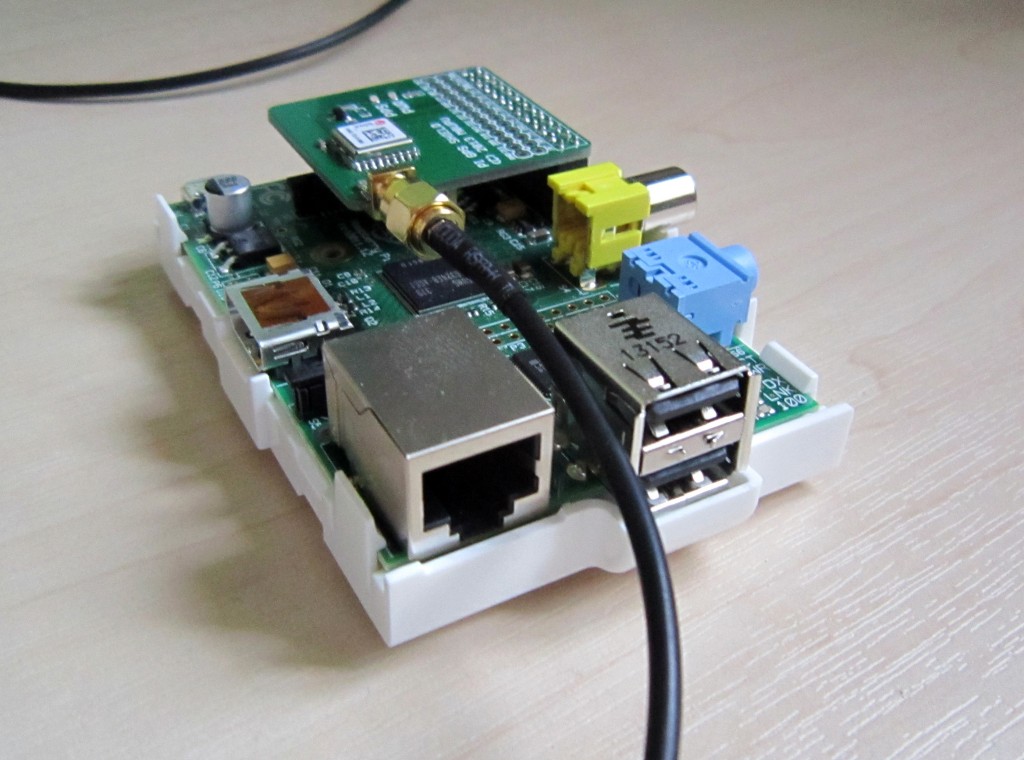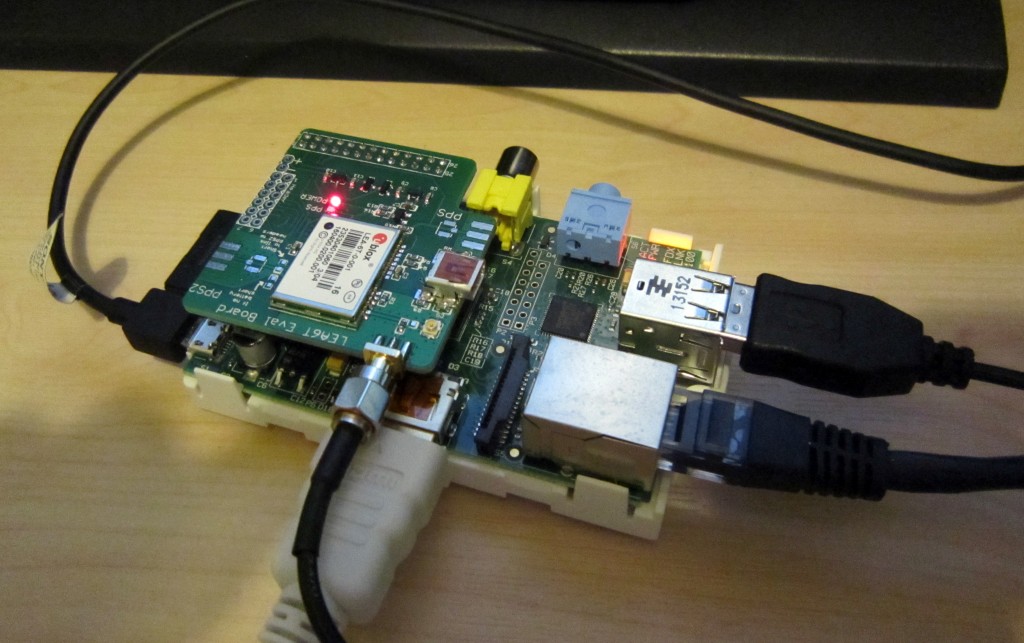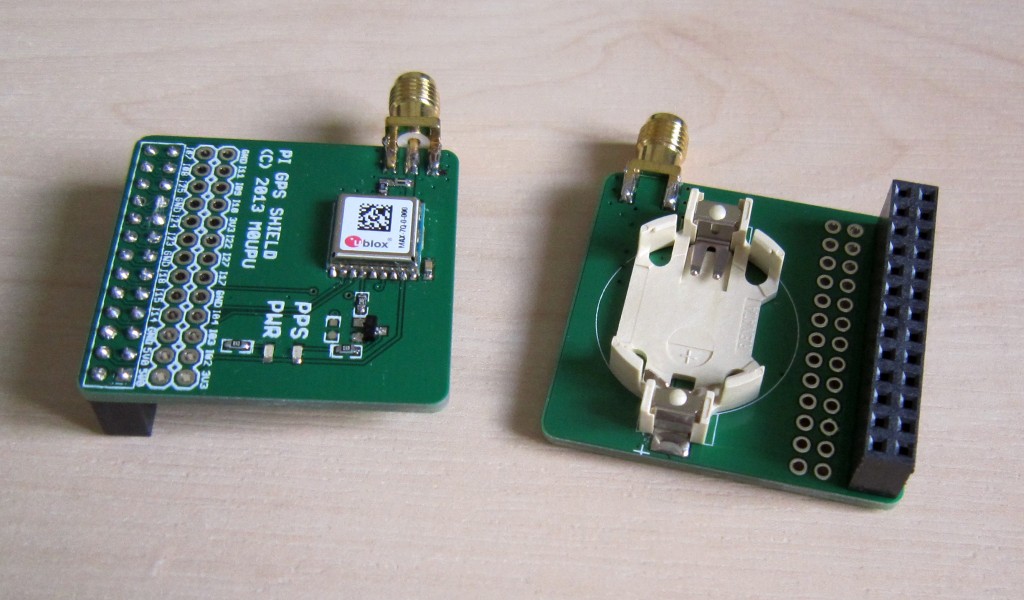Having had a chat with a number of people about my previous LEA based NTPi board here http://ava.upuaut.net/?p=581 a few things were apparent. Firstly designing a board to fit a Pi you’ve removed the composite header from was silly and not checking it on a stock Pi the board results in it not fitting. Secondly the LEA based board is probably more complex that most people need for a Pi based NTP server.
The new positioning modules from Ublox the MAX-7 series are cost effective high performance and provide the PPS output needed for accurate time keeping. I set about designing a simpler board around the MAX-7Q module.
The MAX-7Q positioning module features a RTC Crystal, very low power usage and high performance. Although not a true timing module it is more than adequate for a Pi based NTP Server. Its worth noting the module can, with a serial command, be placed in “Stationary” dynamic mode which is the default mode for the much more expensive timing modules.
Also of note is the PPS output can be, again with serial commands, be increased to an output of up to 10Mhz for other applications.
To keep the board simple it just features the MAX-7Q, a Raspberry Pi header, battery, power and PPS LED’s and provision for an SMA connected active patch antenna (puck) :
The MAX-7Q is connected via serial to the Pi and the PPS is connected to GPIO18 (pin 12). The design is such that it should fit in a case (I’ve only tested it in the Multicomp MC-RP001). The Pi GPIO’s are passed through to an unpopulated header should you wish to connect other items to the Pi. When in place the antenna cable exits between the USB and RJ45 connectors :
 A simple snip of the case with some wire cutters allows the top to be attached :
A simple snip of the case with some wire cutters allows the top to be attached :
Resulting in a nice tidy NTP Server. The made up boards can be purchased from HAB Supplies here http://ava.upuaut.net/store/index.php?route=product/product&path=59_60&product_id=95
I haven’t intended this board to be used in Pi powered HAB stuff due to the way the Pi interfaces with radio the GPS needs to connect via I2C. This board connects the GPS via serial so please bear that in mind.
I also took the opportunity to fix the design fault with the LEA eval board and can also supply these with LEA-6T timing modules or LEA-5S modules as needed. The LEA eval board is designed as more of a multipurpose board featuring PPS and (where LEA-6T fitted) PPS2 outputs. SMA or u.FL inputs. USB to connect to a PC, Pi header to connect to a Pi, generic header for other uses. Board can be powered by header, USB or Pi header. The board does fit in a Pi case but its tight and the antenna exits over the HDMI :
 If this board is of interest leave me a message and I’ll contact you to discuss your requirements.
If this board is of interest leave me a message and I’ll contact you to discuss your requirements.



I am interested in getting accurate timing with the rpi. I currently have an application that recieves data from another source and need to timestamp the data before putting it all out on the network. Do you think this timestamping of the recieved data is an acceptable application for this board? What do you think the accuracy would be? 50 ns?
Evening Tom,
Any non-dedicated NTP hardware will only be good to the millisecond range. I don’t think you’re going to get nano second accuracy out of anything that isn’t dedicated. As a comparison this unit : http://www.timetools.co.uk/solutions/gps-ntp-server-appliance/ gives about 0.003ms -> 0.020ms accuracy. My Pi solution with the GPS module using one of the Time Works Server as a reference keeps time to about 0.185ms. However real world is about +/- 10ms. My Pi based NTP server is here :
http://www.pool.ntp.org/scores/2a00:14f0:e028::7
You can see it is generally around about -5ms offset.
Using PPS with NTP will certainly give your Pi more accurate timing however not to the nano second accuracy. I don’t know what data your time stamping but if it needs accuracy to that region then no, I don’t think the RPi with NTP server is suitable. However for general “IT” level timing you will be hard pushed to beat the Pi + PPS for the cost.
Hope this helps,
Cheers,
Anthony
Hallo Anthony,
on the hab supplies website you can read “It is probably not suitable for HIgh Altitude balloon use” for the HAB-GPSPI Addon Board. What does it mean? Is it a possible solution to combine the RPi with a camera module and the HAB-GPSPI for a HAB experiment?
Thanks for your answer
…Andreas…
Evening Andreas,
Thanks for your comment. Yes I probably should clarify. The Pi GPS board connects the GPS module via serial to the Pi. Now generally, and to date all the Pi’s that have been launched, use the serial ports to drive the radio and link the GPS via I2C which this board doesn’t have. Hence my comment. The Pi isn’t great at accurate timing as it’s a multitasking O/S so the radio generally is driven off the hardware UARTS to get this timing correct. However I understand it is possible to connect the radio to the sound card redirected to a GPIO and generate the correct timing that way. This is witch craft to me so I have no idea how this works but if you can make your radio work without using the hardware UARTS, then it is suitable (it will need to be placed in dynamic model 6 or airborne mode still).
Cheers,
Anthony
Hi Anthony,
can you clarify, if your board uses the PPS sync of the module. If not does your other board include this Input and can you mention their precision?
Thanks
Bernd